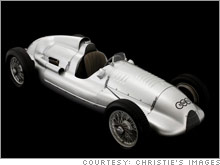'World's most valuable car' fails to sellFollowing postponement to research its background, Hitler-era German race car finds no buyer.NEW YORK (CNNMoney.com) -- After a sale was postponed to answer questions about the car's racing history, an ultra-rare 1939 German racing car expected to fetch the highest price on record for any automobile did not find a buyer at an auction. The results of the investigation revealed that the car did not have the exact history that was originally believed, but that was not expected to substantially alter its value, Rupert Banner, head of Christie's motor cars department, told CNNMoney.com before the sealed-bid auction.
The car, an Auto Union-Grand Prix V12, is one of five remaining "Auto Union D-Types." Its value had been estimated at more than $12 million. The sealed-bid auction was completed March 4. A Christie's spokeswoman declined to comment on the number of bids received or the amount of the highest bid. Christie's plans to auction the car at a later time, the company said, but a date for that has not been set. The car was originally scheduled to be sold in Paris on Feb. 17. That sale was cancelled Feb. 9 when Christie's and Audi Tradition announced that further investigation was needed to confirm the car's racing history. Audi Tradition is a branch of Audi that researches the brand's history and heritage. In the 1930s, Audi was one of four brands that made up Germany's Auto Union car company. Later, after the firm was reconstituted in West Germany following World War II, the company was named Audi but retained the four-ring emblem that symbolized the combination of four companies. In 1933, after becoming chancellor of Germany, Adolf Hitler offered 500,000 reichmarks for a company to design a race car to show off the nation's technological prowess. (At the time, 500,000 reichmarks was equal to about $150,000, or $2.3 million in modern terms, according to the Economic History Services Web site of Miami University of Ohio.) Originally, Mercedes-Benz got the nod. But Ferdinand Porsche, then an engineer working with Auto Union, was able to secure some of that financing to build a revolutionary car he had designed. That basic design was modified over the next few years to become the 1939 Auto Union D-Type, the last of the line. The D-type had a number of features that were extremely advanced for its day, including an engine mounted behind the driver and four-wheel independent suspension. Its twin-supercharged 3-liter V12 engine can produce 485 horsepower, giving the car a top speed of 185 miles per hour. In many ways, the D-type offered a glimpse into what would become the future of racing. It's fundamentally very similar to Formula 1 and Indy race cars of today. "It's the same as a modern day race car, just without fins," Rupert Banner, head of Christie's motor cars department, said in an interview with CNNMoney.com in January. One thing it doesn't have, of course, is modern safety technology. Race cars in those days didn't even have seatbelts. It was seen as preferable to be thrown from the car in a crash. One safety advance the D-type did have was a removable steering wheel, allowing the driver to be more easily removed in case of a fire. D-type cars won several Grand Prix races throughout Europe. This car was originally believed to be the one that won a Grand Prix race in Belgrade, Yugoslavia, the last race held in Europe until after the war. In fact, it was not. The car did race on the famed Nurburgring track in 1939, the investigation revealed, finishing in 5th place. It also finished 6th at the 1939 French Grand Prix, a race in which two other D-types finished 1st and 2nd. The car was one of 18 that were hidden in a mineshaft in eastern Germany during the war. They were discovered by invading Russian troops at the war's end. A number of the cars were subsequently lost or destroyed, according to Christie's. It was taken to Russia after the war, where it was disassembled to study its technology. The car was rediscovered in Ukraine in the late 1980s. It was still in pieces but was otherwise undamaged. Another car discovered nearby had had its chassis sawed in half, Banner said. The current record for a car sold at auction, according to Christie's, is £5.5 million, or almost $11 million. That was paid for a 1931 Bugatti Type 41 Royale Sports Coupe sold by Christie's in 1987. Ferdinand Porsche also designed another car for Hitler, but for a very different purpose. That car, inspired by the success of the inexpensive Ford Model T in the United States, ultimately became known as the Volkswagen Beetle. It also had a rear-mounted engine, as do today's Porsche sports cars. BMW's Hydrogen 7: Future or flop? |
|

